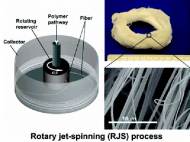Creating nanofibers like cotton candy
 Bioengineers at Harvard University came up with a new technology with a great potential in nanofibers production, and they refer to it as a “cross between a high-speed centrifuge and a cotton candy machine”. The invention could find many uses in industry, with potential applications ranging from artificial organs and tissue regeneration to clothing and air filters.
Bioengineers at Harvard University came up with a new technology with a great potential in nanofibers production, and they refer to it as a “cross between a high-speed centrifuge and a cotton candy machine”. The invention could find many uses in industry, with potential applications ranging from artificial organs and tissue regeneration to clothing and air filters.
“This is a vastly superior method to making nanofibers as compared to typical methods, with production output many times greater”, said Kit Parker, Thomas D. Cabot Associate Professor of Applied Science and Associate Professor of Bioengineering in the Harvard School of Engineering and Applied Sciences (SEAS). “Our technique will be highly desirable to industry, as the simple machines could easily bring nanofiber production into any laboratory. In effect, with this technique we can mainstream nanotextiles.”
Most common method of creating nanofibers today is through electrospinning – a process where high voltage electric change is sent into a droplet of polymer liquid to draw out long wisps of nanoscale threads. The Harvard researchers turned to rotary jet spinning – a process where polymer material is quickly fed and rotated inside a reservoir atop a controllable motor offers more control and greater yield.
When spun, the material stretches much like molten sugar does as it begins to dry into thin, silky ribbons. Just as in cotton candy production, the 100 nanometer-diameter polymer-based threads are extruded through a nozzle by a combination of hydrostatic and centrifugal pressure. The resulting pile of extruded fibers form into a bagel like shape about 10 cm (4 inches) in diameter.
“The new system offers fabrication of naturally occurring and synthetic polymers as well as a lot of control over fiber alignment and web porosity, hierarchical and spatial organization of fibrous scaffold and three-dimensional assemblies”, said Mohammad Reza Badrossamay, lead researcher who is a postdoctoral fellow in the Wyss Institute and member of Parker’s lab at SEAS.
The researchers tested the new device using a variety of synthetic and natural polymers such as polylactic acid in chloroform, a biodegradable polymer created from corn starch or sugarcane that has been used as eco-friendly alternative to plastic in items like disposable cups. Another advantage of the method is its flexibility regarding fiber diameter which can be easily manipulated, shape of the fibers can also be altered, ranging from beaded to textured to smooth.
Since the end-result 3D structure shape can be set by varying how the fibers are collected, Parker’s Disease Biophysics Group used the technology to form tissue engineering scaffolds, or artificial structures upon which tissue can form and grow. The researchers expect to further refine the process for tissue engineering applications and to look for opportunities to exploit the methodology in other potential applications.
For more information, read the paper published in Nano Letters: “Nanofiber Assembly by Rotary Jet-Spinning”.









This method is reported (“Electrospinning to Forcespinning™“, Sarkar et al, Materials Today, Vol. 13, No. 11, pp. 42-44, November 2010) and already patented (US Patent 8,231,378, dated July 31, 2012). Commercial and industrial products are already available from FibeRio Technology Corporation, Edinburg, Texas.
author
I actually read it in order to moderate your comment, but the method does look remarkably similar.
However, they did find other applications for the methodology.